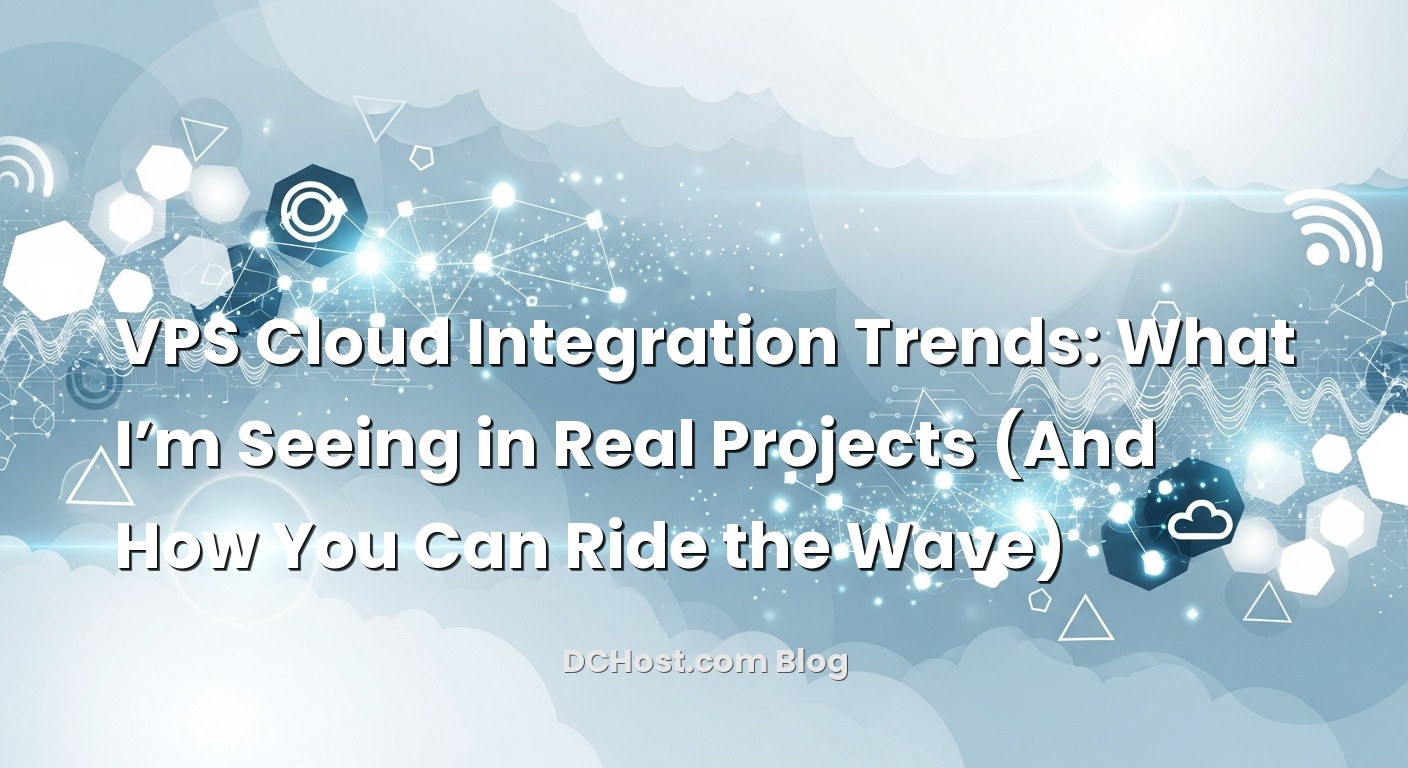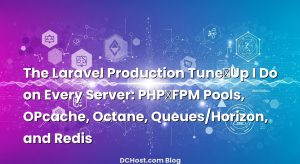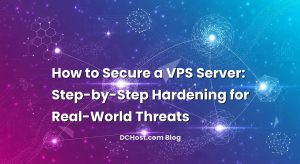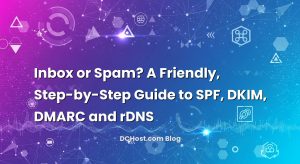So there I was, staring at a cluster dashboard over a lukewarm coffee, when a client pinged me: “Can we move this queue to the cloud but keep the API on our VPS?” I smiled, because that question has become the soundtrack of my week. Ever had that moment when your setup is mostly fine, but you just know it could be smarter, lighter, and more resilient if the pieces talked to each other better? That’s where we are with VPS cloud integration. It’s not about flipping a switch and declaring victory; it’s about wiring together a few reliable building blocks so your stack feels calm even when traffic spikes or something fails at 3 a.m.
In this post, I’m going to walk you through the big VPS cloud integration trends that are actually working in real projects right now. We’ll talk about hybrid setups, containers and GitOps, edge and networking moves, performance tweaks with NVMe and caching, observability that doesn’t drown you in noise, and a security story that won’t keep you glued to your firewall logs. I’ll share where the bumps are too—the small trade-offs that matter when you’re trying to ship something without overengineering it. Think of this as a conversation between friends who both love a fast site and a quiet pager.
İçindekiler
- 1 The New Meaning of “Cloud Integration” for VPS
- 2 Hybrid and Multi‑Cloud, Without the Drama
- 3 Containers, GitOps, and the “Steady Hand” of IaC
- 4 Edge, Networking, and the Quiet Rise of IPv6
- 5 Performance Foundations: NVMe, Caching, and Calm I/O
- 6 Observability and FinOps: Alerts That Help, Costs That Make Sense
- 7 Security and Compliance: Practical, Layered, and Boring (in the Best Way)
- 8 Real‑World Patterns I Keep Reusing
- 9 A Quick Word on Automation (So You Don’t Babysit)
- 10 Where Serverless Fits (and Where It Doesn’t)
- 11 Practical Networking Habits That Pay Off
- 12 When a Small Orchestrator Makes Sense
- 13 Putting It All Together: A Calm, Fast, Integrated VPS
- 14 Wrap‑Up: Your Next Three Moves
The New Meaning of “Cloud Integration” for VPS
When people hear cloud integration, they sometimes picture a dramatic cutover to a shiny managed platform and a triumphant high five. That’s not what I see most of the time. What I see is quieter and more pragmatic. The VPS remains the home base. It’s where your application lives, where your team feels comfortable, where you can SSH in and see what’s going on. The cloud becomes a set of power outlets around the room—managed databases, queues, storage, CDNs, serverless bits—that you tap into when it makes sense. The magic is not the individual services; it’s how cleanly they connect to your VPS and how reliably they fail when something goes sideways.
Here’s the thing: a lot of integration wins are small moves that stack up. You offload object storage to something durable, push static assets to the edge, put queues on a managed service to shed some ops burden, and maybe let a cloud-managed database carry the heavy reads. Meanwhile, your core app retains its identity, its predictable cost profile, and its comfort zone on a VPS you understand. That balance—own your core, outsource the spiky edges—has been a surprisingly resilient trend.
And yes, the network is the unsung hero here. The cleanest integrations are the ones where DNS, caching, and transport are deliberate. I’ve lost count of how many “we had downtime mid-migration” stories end with a sheepish, “we forgot to plan TTLs.” That’s why I love pointing folks to the TTL playbook for zero‑downtime migrations—it turns a scary cutover into a neat little trick.
Hybrid and Multi‑Cloud, Without the Drama
One of my clients runs a busy WooCommerce store on a VPS. They needed a seasonal burst of compute for image processing and wanted a managed queue that wouldn’t become our 2 a.m. babysitting job. We kept the shop on the VPS, built a small worker layer that could spin up in the cloud when needed, and used a CDN to hide the distance between the two. It felt like cheating, but in a good way. We didn’t make a grand architecture diagram and then fight reality; we picked two integration points and let the VPS remain the anchor.
The trick is to know what belongs where. In my experience, the workload that benefits most from cloud integration is the one that’s either bursty, embarrassingly parallel, or just better off managed by someone who runs that service at scale. Your cart and checkout? Keep it close. Your image thumbnails? Outsource the marathon. Your static assets? Push them outward. When you’re deliberate in this way, you stop paying for noise and start paying for the parts that move your stack forward.
Networking-wise, this is where clean DNS strategies, predictable SSL automation, and thoughtful routing help your VPS and cloud services feel like neighbors instead of long-distance acquaintances. If you’ve ever juggled records under pressure, you know why setting the right TTL in advance is worth its weight in uptime. The less glamorous part of hybrid—knowing how long caches hang on and how long clients remember old addresses—is often the difference between a smooth rollout and a very long afternoon.
Containers, GitOps, and the “Steady Hand” of IaC
Let’s talk about containers. They’re not a trend anymore; they’re a guardrail. On VPS projects, containers give you a clean package for your app and its dependencies, and that clean package becomes your negotiation chip with any cloud service you integrate. When your app is consistent, your integrations don’t have to babysit deployments. I’m not saying you need full-blown cluster orchestration for every project; I’m saying that containerizing your workloads makes hybrid feel less like a balancing act and more like a routine.
GitOps is the other steady hand. You commit your infrastructure changes, your deployment manifests, your tiny tweaks to caching headers, and let automation pull the rope. The reason this trend keeps gaining steam is simple: fewer surprises. When your VPS and your cloud resources are both described in code, you stop playing guess-the-state. Tools like Terraform make that fewer-surprises promise very real. If you haven’t peeked at the Terraform documentation in a while, it’s worth a coffee and a skim. The point isn’t to master every module; it’s to get comfortable with the rhythm of describing your world in files and letting pipelines do the heavy lifting.
And sure, orchestration has its place. If your workloads are numerous, spiky, or you just like the way a control plane keeps things neat, a small cluster on a VPS can be beautiful. You can start tiny—no grand declarations needed—and let yourself grow into it. The official Kubernetes documentation is a great sanity check whenever you’re tempted to reinvent a scheduler with bash scripts. But keep it honest: if a single-node container runtime on one VPS solves your whole problem, that’s a win, not a failure to “go cloud.”
Edge, Networking, and the Quiet Rise of IPv6
I sometimes joke that the edge is just where your users are, plus a dash of caching. But that little dash is changing the game for VPS cloud integration. When you push static assets and even small fragments of HTML out to the edge, your VPS breathes easier. Everything feels faster, and your cloud integrations (like image processing or a search service) stop amplifying latency. The new pattern is not to send the world back to your origin for every little thing. You teach the edge what’s safe to serve, let your VPS focus on the dynamic parts, and your users get a snappier experience.
Networking has its own trend: clean IPv6 rollouts that don’t feel like science projects anymore. I’ve been seeing more projects take the plunge because it’s simply the path that keeps traffic flowing smoothly as providers and networks shift their defaults. If you’re on the fence, I’d suggest reading why IPv6 adoption is suddenly everywhere and what it means for your site. It’s not about checking a box; it’s about better routing, fewer translation headaches, and a setup that ages gracefully. When you stitch a VPS to cloud services over IPv6-enabled paths and pair that with sensible edge caching, you remove a lot of invisible friction.
One memorable integration involved a content-heavy website where the VPS carried the app, a cloud service handled full-text search, and the edge did most of the heavy lifting for media and HTML shells. We used short TTLs to introduce changes carefully and then stretched them out once everything was quiet. It felt more like tuning an instrument than building a pipeline. The magic wasn’t the tech list; it was the way each piece knew its job and got out of the way.
Performance Foundations: NVMe, Caching, and Calm I/O
If there’s a heart to VPS performance right now, it’s NVMe. When your I/O is snappy, your whole integration story gets easier. Database stalls don’t cascade, background workers don’t block, and your VPS becomes a stable base for the cloud services surrounding it. I’ve migrated teams from older storage to NVMe and watched their “mysterious spikes” vanish. If you want a friendly deep dive into what’s really going on under the hood, the NVMe VPS Hosting Guide is a great way to make the performance story tangible—no lab goggles required.
Cache strategy is the other half of performance. On integrated setups, caching becomes diplomacy. You decide what the edge should cache, what the app should cache, and what the database should keep warm. When you get that balance right, your VPS stops getting pestered for the same content and your cloud services stop doing busywork. I like to push as much static as possible to the edge, keep object caches close to the app, and let the database carry the hot keys that deserve it. There’s no one-size-fits-all here, but there is a simple goal: keep the hot path short.
I remember a migration where simply moving logs and media to object storage cut the noise in half. CPU graphs looked boring in the best possible way. The app felt crisp, and the VPS didn’t “sigh” when backups ran. That’s how you know you’re moving in the right direction—your graphs look a little sleepy and your support inbox goes quiet.
Observability and FinOps: Alerts That Help, Costs That Make Sense
The moment you start wiring a VPS to cloud services, observability becomes your north star. You don’t need a wall of dashboards; you need the right few signals at the right moments. A lot of teams find peace when they instrument their nodes, set calm alerts, and let the tools do the nudging before users notice. If you’re wondering how to set that up without drowning in graphs, I’ve shared the exact approach I use in the playbook I use to keep a VPS calm with Prometheus and Grafana. The outcome you want is simple: a few practical alerts that say “hey, check this now” rather than a chorus of false alarms that trains you to ignore everything.
On the tracing side, I like keeping it light and consistent. If you’re exploring distributed traces across your VPS and cloud endpoints, the OpenTelemetry docs are a thoughtful way to start. The goal isn’t to trace every packet; it’s to follow the critical path your users care about and find the slow steps quickly. Most issues in hybrid setups show up at the seams, so put your eyes there: network edges, cache layers, and service boundaries.
As for costs, the story is steady: keep the VPS as your predictable anchor and let the cloud fill in the bursty gaps. FinOps isn’t a new billing department; it’s a habit of checking the hotspots where costs can creep. A monthly ten-minute check-in on network egress, object storage growth, and managed queue usage pays off in sanity. The best part of hybrid done right is how it lets you keep a firm grip on your baseline while buying elasticity only when you need it.
Security and Compliance: Practical, Layered, and Boring (in the Best Way)
Security in a VPS + cloud world is less about shiny tools and more about layers that add up to a boring incident log. You want a WAF at the edge, clean TLS, hardened SSH on the VPS, sane firewall rules, and a habit of patching that doesn’t keep you up at night. Most of the work is rhythm: rotate secrets, segment services, and don’t give every container the keys to the kingdom. The better your segmentation, the smaller the blast radius if something slips through.
Compliance is another area where VPS cloud integration can actually help, not hinder. When data locality matters, you keep the sensitive bits on a VPS in-region, with clear logging and deletion policies. You can still integrate with cloud services as long as you’re deliberate about what crosses the line and what stays put. If you want a real-world walkthrough of that approach, I wrote about KVKK and GDPR‑compliant hosting without the headache, focusing on data localization, retention, and sane deletion practices. It’s not glamorous, but it’s surprisingly manageable once you’ve wrangled a few workflows.
Automation helps here, too. I like describing security and network posture with code, so changes are reviewed and tracked right alongside the app. That’s part of the GitOps glow: you’re not relying on memory and heroics. While you’re at it, keep DNS clean and predictable—again, that TTL playbook for zero‑downtime migrations pays dividends in security rollouts, not just traffic switches. When you can steer traffic quickly and calmly, you sleep better.
Real‑World Patterns I Keep Reusing
Let me share a handful of patterns I find myself using over and over. First, the “quiet hybrid” pattern: origin app on a VPS, CDN in front, object storage for media, and a managed queue for background tasks. This one is perfect for busy sites that have predictable core traffic and unpredictable spikes in processing. You get the cost clarity of a VPS plus the elasticity of the cloud, and the user experience just feels faster because you’ve shortened the hot path.
Second, the “containerized spine” pattern: package the app in containers even if you’re not going full cluster. You gain consistent deploys and low-friction portability. Later, if you decide to move that container to a small orchestrator or a serverless container platform for a burst, you’re ready. It’s not about making everything micro; it’s about making everything moveable without drama.
Third, the “observability first” pattern: before the big change, put in the signals. A little Prometheus on the VPS, a few service-level checks at the edge, and traces across the critical requests. If you can see the boundary between your VPS and each cloud service, you’re in control. Most migration anxiety isn’t about the move itself; it’s about not knowing what will happen. Turn on the lights, and the room looks a lot less scary.
Lastly, a performance note that always comes back to help: when your I/O is calm, everything else feels easier. NVMe isn’t a bragging right; it’s a stress reducer. If your platform is built on solid storage and your caches are used intentionally, you can plug cloud services in and out without worrying that one bad day will bring the house down. If you want the full nuts-and-bolts story behind that, the NVMe VPS Hosting Guide breaks it down in plain language.
A Quick Word on Automation (So You Don’t Babysit)
The quiet hero in all of this is automation. Whether you’re using a simple CI/CD pipeline to build and ship containers to your VPS or a more elaborate GitOps flow that reconciles state for you, the win is the same: fewer surprises. I’ve seen teams spend weeks planning a migration and then trip on a missed config change that someone typed by hand. Once they moved those settings into code and added a checkpoint in the pipeline, that class of mistake basically disappeared.
If you’re picking a place to start, containers and Terraform are a friendly pair. Package your app so it runs the same way on your laptop and your VPS, then describe a tiny piece of infrastructure as code and watch how it feels. You don’t need a full-bore platform on day one. You need one good loop that builds confidence. Before long, you’ll be versioning DNS tweaks, edge cache rules, and even firewall changes in the same repos where your app lives. That’s how teams get consistency without turning into a bureaucracy.
And when the time comes to add a coordinator—maybe a small orchestrator or a deployment agent that picks up the latest manifest—you’ll already be working in a way that makes that addition easy. You won’t be inventing a process under pressure; you’ll be extending one that already works.
Where Serverless Fits (and Where It Doesn’t)
People often ask whether they should go serverless instead of using a VPS. I love serverless for small, focused tasks, especially when it’s tied to an event and doesn’t need a full runtime hanging around. Think webhooks, resizing jobs, quick transforms, and scheduled chores that don’t deserve a whole service. In a hybrid setup, these functions live happily next to your VPS, taking the annoying edges off your workload.
But here’s the boundary I keep seeing: when your workload benefits from warm caches, local compute, and steady state, a VPS gives you a kind of predictable muscle that’s hard to beat. I’m happy to push bursty processing and glue code into the cloud while letting the VPS carry the app that demands locality and speed. That mix preserves simplicity where it matters and adds flexibility exactly where it’s useful.
If you’re already thinking in containers and GitOps, you’ll find it natural to drop a function into the flow when it helps. You’ll have the logging, metrics, and secrets flow already in place. That’s the part that feels like a superpower—your approach scales across different runtimes without changing your habits.
Practical Networking Habits That Pay Off
I can’t talk about VPS cloud integration without geeking out about DNS and TLS for just a second. A few simple habits make everything smoother. Keep short TTLs while you’re staging a change; stretch them once you’re stable. Automate certificate issuance and renewal so you’re not setting calendar reminders for the worst possible day. Document which services talk to which, and don’t be shy about segmenting by hostname when it makes routing or caching easier. Small boundaries create big clarity.
On the connectivity side, consistency beats cleverness. If you’re running tunnels or private links, spend time naming and tagging the routes so your future self can make sense of it at 11 p.m. Remember that edge caching and compression settings are part of the transport story, not just “performance extras.” They shape how your traffic flows and where your VPS does work, which becomes very real when you add cloud services into the mix.
If you want to go deeper on network behaviors during moves, keep a copy of the zero‑downtime TTL strategies in your bookmarks. It saves you from white-knuckle cutovers and helps you design with confidence. That calm shows up on every graph.
When a Small Orchestrator Makes Sense
There comes a point where a single machine running a few containers starts to feel a little crowded. Maybe you’re rolling updates a bit too manually, or maybe you want to scale a worker without SSH gymnastics. That’s when a small orchestrator starts to make sense. It doesn’t need to be an empire. Even a tiny control plane that understands how to roll pods gradually, restart them when they misbehave, and keep secrets separate will make your life easier.
I’ve seen teams begin with a one-node setup, add a second node for breathing room, and call it a day for a long while. The win is the operational consistency—it’s much easier to stitch cloud services to a platform that handles workloads predictably than to a machine that needs handholding. And if you outgrow it, you’ve got a clean path forward without having to repackage your app.
If you’re curious about a gentle starting point, the Kubernetes docs are good for validating your instincts. Pair that with the Terraform documentation for the parts you want to define in code, and you’ll be surprised how quickly your environment starts feeling tidy.
Putting It All Together: A Calm, Fast, Integrated VPS
Let me paint a picture I’ve helped teams build again and again. You’ve got a VPS running the app on NVMe-backed storage, containerized so deploys are clean. Static assets flow to object storage and out through a CDN at the edge. A managed queue takes on bursty background work. A managed search service offloads the heavy indexing and full-text read paths. Observability runs on the VPS with a steady dashboard and quiet alerts. Traces follow the app through its cloud neighbors. TLS is automated. DNS changes are deliberate, with short TTLs during change windows and longer ones once the dust settles. IPv6 is enabled, so your traffic takes the cleanest route your users can reach.
That setup doesn’t need to be flashy to feel incredible. It just hums. You spend less time babysitting, more time rolling out the features your users actually notice. And when the business side says, “We need to handle the holiday rush,” you nod, scale the bursty parts in the cloud, and keep the VPS steady. It’s the best of both worlds without trying to become your own cloud provider.
When folks ask for a checklist, I smile and suggest a story instead: make the hot path short, the deployment path boring, the storage fast, and the network predictable. Everything else is seasoning.
Wrap‑Up: Your Next Three Moves
Let’s land this. If I were sitting across from you with a fresh coffee and a marker, I’d sketch three moves to ride the VPS cloud integration wave without getting swamped. First, containerize the core app and add a simple CI pipeline that ships reliably to your VPS. Nothing fancy—just consistent builds and predictable releases. Second, take the easy performance wins: move static assets outward, adopt NVMe on your VPS, and set edge caching that respects your content. If you want a clear map, the NVMe VPS Hosting Guide is a friendly place to start. Third, make observability and DNS your safety net. Wire up calm alerts with a playbook like Prometheus and Grafana on a VPS, and keep that TTL guide for zero‑downtime moves within reach.
From there, lean into IPv6 for cleaner routing with a quick read of why IPv6 adoption matters, stay mindful about data locality with KVKK and GDPR‑friendly hosting practices, and keep experimenting in small, reversible steps. You’ll find your groove fast. Hybrid isn’t about perfection; it’s about that satisfying feeling when your stack does its job and lets you get back to building the thing you set out to build. Hope this was helpful. See you in the next post—bring your questions, and I’ll bring the coffee.





